Robert Raymer's Blog, page 7
June 1, 2017
Arte: Somerset Maugham and Me—Upper Sarawak River—Part IV
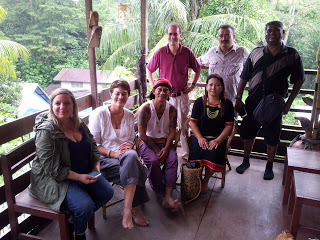 Laure, Karen, Peter, our host, Robert. Alvin, Shan
Laure, Karen, Peter, our host, Robert. Alvin, ShanMonday morning while visiting Semenggoh Wildlife Centre, I finally got to meet Peter John, Karen’s Iban husband, who arrived barefoot and dressed for the part of a traditional upriver Iban. My wife had Googled Peter the night before, so I saw a picture of him in London, and recognized his face, but not in those clothes…
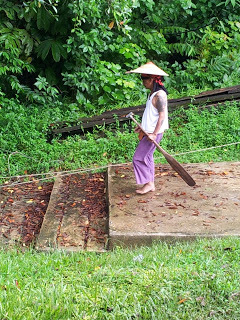
We arrived in time for the 9:00 am feeding, but since orangutans don’t wear watches they don’t always come for their appointed times, especially during fruit season. Forty minutes had passed before they finally answered the call, a mother and an infant, not to the feeding area, but a clearing opposite of the entrance. Before we went to see them, and after the other tourists had left, Richard took some shots of me walking through jungle.
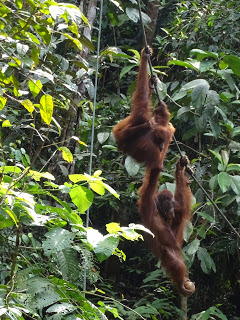
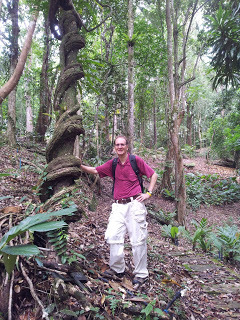 Later, at another section of Semenggoh they considered filming me for my interview in the jungle but the steady drone of traffic couldn’t be avoided, so Richard settled on taking additional shots of me making my way through various patches of jungle.
Later, at another section of Semenggoh they considered filming me for my interview in the jungle but the steady drone of traffic couldn’t be avoided, so Richard settled on taking additional shots of me making my way through various patches of jungle. Laure and Richard became excited when Karen located wild pepper growing on a rather tall tree, perfect for their pepper story.
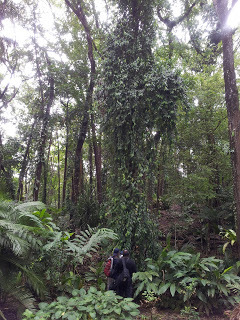 wild pepper
wild pepper
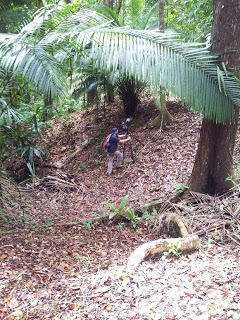
I had been looking forward to riding in a longboat on the upper Sarawak River, but once we reached Kampung Giam, we brought the rain with us and had to wait it out on the veranda at Homestay Kampung Giam, run by a friend of Peter’s. We drank tea, ate muffins and curry puffs, and took groups photos.
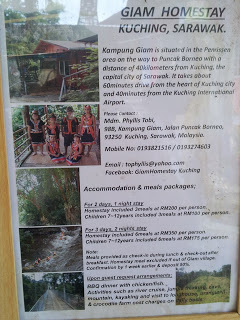
When the weather broke, Richard filmed Peter and a Bidayuh, the owner of a longboat they had hired, as they made a tricky ninety-degree turn from the tributary onto a faster paced upper Sarawak River bloated by the recent rain. He filmed them leaving, while Michel got a wider river view from his drone. For some reason, the drone dropped among the elephant grass on the far side of the river, so Peter had to retrieve it. They were just glad it didn’t land in the river.
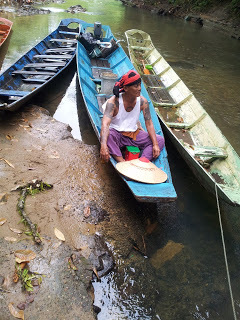
Michel tested it, and it seemed okay, so they picked up on their filming where they had left off. Before they went upriver toward Kampung Git, Karen had lobbied on my behalf, but Laure had assured her that I would be sent for later, though logistically we weren’t sure how that could be arranged since we would be out of communication.

I shrugged off my disappointment, having resigned myself that there would be no longboat trip for me, and joined the others in the van….Along the way we stopped for lunch and Alvin regaled us with stories from his special forces days; he was quite entertaining and even told us how to make a traditional poison that wives often used to kill their husbands that could take up to three months; gradually the stomach would be coated and unable to absorb food and then all trace would be gone. It was quite ingenious, though I was glad my wife was not present.
At Kampong Git, I was chatting with Karen on the beach, while Michel took drone shots over the river, when a longboat approached. I recognized the Bidayuh and he said in his very limited English one word, “Drone,” so we called Michel and got him and his drone into the longboat. Then he said, “Two,” and Karen interpreted that to mean “two people”, that they were also sending for me to finish off the Maugham sequence as Laure had promised.
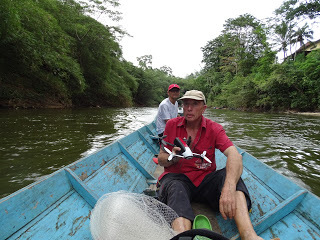 Michel Viet and his drone
Michel Viet and his drone
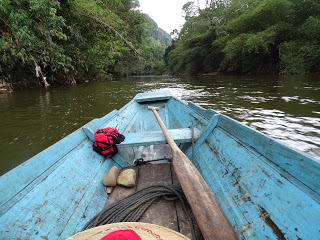
There we were, the three of us going upriver….Twenty minutes later, we ran out of gas; luckily he had some spare in a container and we arrived ten minutes later on a beach—a pebbled spit of land at the edge of the river where Richard was filming Peter cooking fish and rice inside various bamboo.
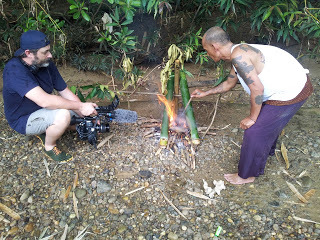
Richard was not at all pleased because we failed to bring his tripod! The Bidayuh only said two words and neither of those words was “tripod”. I don’t know why no one thought to jot down a message to give us; besides we thought they had loaded the tripod for the first trip. Then I began to wonder, when he said “two” did he mean “two items: drone and tripod….Suddenly, I felt like a third wheel.
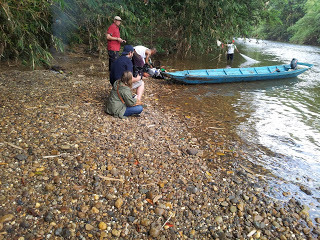
When the drizzling rain began to disrupt the filming, Laure remained unflappable as she waited it out with minimal fuss and no dramatics. She and Richard had been there before—grumbling never helps and patience with a positive attitude can go a long ways. Richard had addition concerns, his filming equipment, his spare lens and the other photographic gadgets that he needed to make sure they got the best shots under the worst lighting situations.
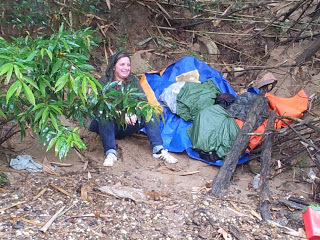
When the drizzle became a downpour, Richard covered his equipment with a heavy duty poncho, a tarp from the longboat, and my poncho as an extra layer of protection.
Borneo rivers have a nasty reputation of rising quickly; in no time, water had made inroads to where all the equipment had been placed. Noticing that his backpack was getting wet, Richard started grabbing stuff and we all pitched in to move everything as quickly as possible to higher ground, under the trees. Ourselves, included.
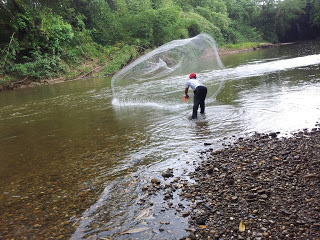
Once the rain stopped, the Bidayuh continued to fish using a weighed net casting it into the river, while Richard picked up where he had left off taking close ups of Peter cooking fish and lemang and potatoes and prawns with lemongrass in a large bamboo. It smelled and tasted delicious when it was served on large leaves plucked from the nearby jungle.
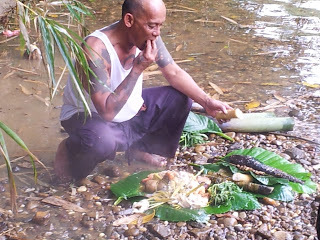
We also tried plump sago worms cooked in an open fire, which tasted fine, though I would’ve preferred marshmallows.
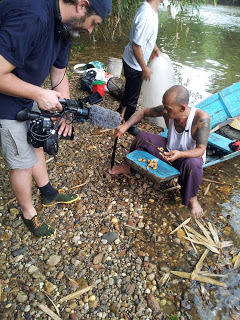
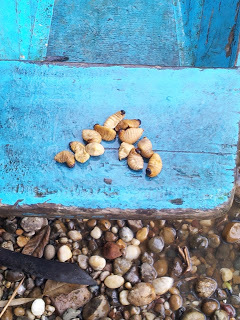
Looking at Peter in this setting you would never have imagined that he studied in the US and lived in London for a number of years and was a deejay in Singapore with a deep voice. But here, he could be an Iban from generations ago, with headhunting in his blood, living off the land.
Since he had no tripod, Richard had to use an overturned bucket for storing fish to sit on and did his best to keep the movie camera still while filming Peter at the helm of longboat as he talked about his life as an Iban living in Sarawak.
For me, just being there was a pleasure watching the French crew work. Having worked together for twelve years, Laure and Richard knew each other’s idiosyncrasies. They had developed a level of trust in each other. They were professionals—they both wanted a good product that they could be proud of. Basically they were a one woman, one man team, who got help along the way, like with Michel and his drone, whom they flew from Kuala Lumpur to Kuching for the rest of the Maugham shots, the pepper story and the Personal Invitation piece on Peter.
They also had KL based Shan, who liaises with film productions from oversea, offering them logistical assistance, Alvin their driver cum tour guide who assisted many different ways, including sourcing for jungle locations to film, and us, their filming subjects, quick to offer suggestions and tips and bring in others to assist like Karen whose proved invaluable for her production assistance into putting together the complicated pepper story through her myriad of connections.
Laure told me that Richard always wanted the better shot, not a merely good shot; at times, when weather and daylight were working against them, sometimes you just need to get any shot that you can under the circumstances, which was better than no shot! Still the compromised shots they did get were always better than what Laure was willing settle for….Richard had good instincts; he knew what he was doing, and Laure was only too happy to work with him.
Sometimes holding out for that last great shot would pay off as we soon discovered when they filmed my final Maugham segment in Part V.
—BorneoExpatWriter
Continue to Part V (*available soon) Link to Part I, Part II, Part III,
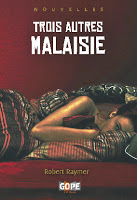 Book orders for Trois autresMalaisie. E-book orders.
Book orders for Trois autresMalaisie. E-book orders.
Here's a link to the intro and excerpts, and to four reviews of Trois Autres Malaisie ineurasie.net, Malaisie.org, easyvoyage.com, and Petit Futé mag .The ARTE TV report will be broadcasted on June 5th: http://www.arte.tv/fr/videos/071100-062-A/invitation-au-voyage. It will be available online until August 4th!
Published on June 01, 2017 08:42
May 31, 2017
Arte: Somerset Maugham and Me—Filming at My Office for the French—Part III
As of Saturday the French crew and Karen were still going back and forth as to whether they were coming to my house to film on Sunday or Monday while trying to work out their shooting schedule for the Sarawak pepper story because they would only have access to Michel’s drone until Tuesday since he would be returning to France. Finally they agreed that after the Fort Margherita shoot to come to my house.
I knew my wife Jenny was getting anxious, so I told her on Sunday morning before I left the house for Fort Margherita, I would text her with the latest details—when they were coming and how many. Her biggest concern was having to answer a question on Somerset Maugham. I assured her they just wanted to meet my Bidayuh family.
 Dressed for Gawai!Laure was delighted when I told her about Jenny’s German and French connection—she works for X-Fab, a German company that had recently expanded into France. Also my mother’s side of family came from France as part of the Huguenots expulsion in 1572 and eventually arrived in America in 1630. My father’s side mostly came from Germany, having arrived in America in the early 1800’s. So you can say I am also a Franco-German project, ideal for the Franco-German Arte.
Dressed for Gawai!Laure was delighted when I told her about Jenny’s German and French connection—she works for X-Fab, a German company that had recently expanded into France. Also my mother’s side of family came from France as part of the Huguenots expulsion in 1572 and eventually arrived in America in 1630. My father’s side mostly came from Germany, having arrived in America in the early 1800’s. So you can say I am also a Franco-German project, ideal for the Franco-German Arte.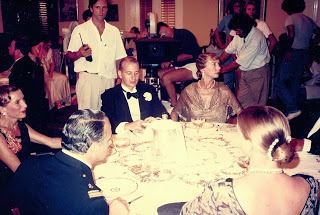
Laure was thrilled that I had another French connection, as a tango dancer in the film Indochine . She said she was a big fan of Catherine Deneuve and was delighted when I showed her some photos from the shooting. Indochine was a period piece, between the wars, when dinner guests dressed up...even in remote corners of the world as they did here in Sarawak when Maugham visited.
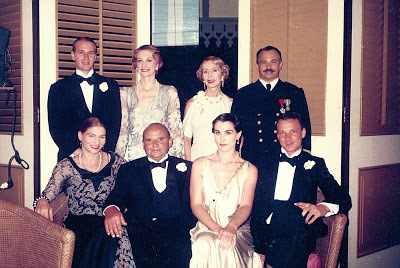 The Indochine Tango Dancers. standing Robert Raymer, Joelle St-Arnoult, Angela and Lee Clark;
The Indochine Tango Dancers. standing Robert Raymer, Joelle St-Arnoult, Angela and Lee Clark; seated Anni Nordmann, Andre Cluzaud, Laurence, Seibert Kubsch
Looking back, I had to admit I seemed rather dashing (wearing a tuxedo, having makeup and your hair professionally styled helped). I feel far less dashing today with a lot less hair.
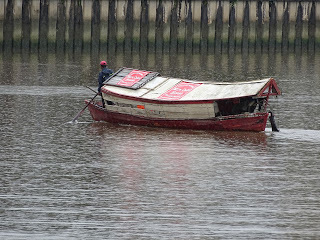
After we finished filming at Fort Margherita, after taking another tambang across the river, after some delays searching for a bank to transfer money from France and a late lunch, I left early since the others were coming together in a van. We seemed to be picking up people, too, so I kept updating Jenny, they’ll be four, no make that five, now it’s six—not including me. I arrived home with just enough time to take a quick shower and a change of clothes. In fact, I was stepping out of the shower when they arrived.
Feeling refreshed and serving them refreshments of orange slices and Danish cookies and a few local tidbits to snack on, I presented myself to Richard who wanted to film me inside my office. He took some artistic shots of me reflected on the glass of two bookcases, alongside a sketch portrait for a clever double imagine, and additional shots behind me.

I was awfully glad that we recently redid my office, adding some nice cabinets and additional light. I even had framed copies of my books on top of one of the cabinets, including Trois autres Malaisie, the book that had attracted the attention of Laure Michel back in France. I was also glad my wife insisted I get a haircut!
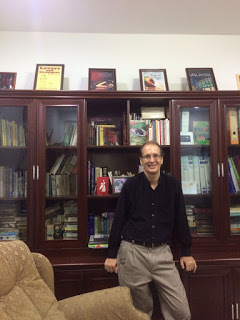
Needless to say my children, Jason 12 and Justin 10 were amused; maybe even a little impressed….All this fuss over their stay-at-home-writer-father….The younger one, who is the reader and writes his own stories, took the most interest as I prattled on about Somerset Maugham and the District Officers that he wrote about on those lonely outstations who often took in a local woman as a “sleeping dictionary”, a common practice then in Sarawak, though frowned upon in Malaya.
These were not women they would marry; they would cohabitate with them, bear children with them, but if they wanted a “real” wife, they would return to England and find one, often on short notice, and bring them back with them, as Maugham described in “The Force of Circumstance.”
Guy had a local woman for ten years and three half-caste children, a detail he forgot to tell Doris when he asked her to marry him and follow him to Sarawak, to a remote outpost alongside a Borneo river. When the previous “wife” kept coming around the property, Doris would enquire about her and her children, as to who was their father.
Guy replied, “Oh, my dear, that’s the sort of questions we think is a little dangerous to ask out here.”
But then she learned the truth—that these kids were his. Unable to accept this new reality, Doris eventually returned to England, so Guy moved his native “wife” and three kids back in.
Nowadays these so called “half-caste” children are considered mixed or pan-Asian, having inherited “the best” from both parents. We’re proud of our children and the fact they are bi-lingual and have inherited two cultures can be an advantage.

I then talked about how Maugham got ideas for his short stories, largely from three sources.
One: his notebook. “I filled my notebook with brief descriptions of their appearance and their character, and…stories began to form themselves...” He also wrote, “I have taken living people and put them into the situations, tragic and comic, that their characters suggested. I might well say that they invented their own stories.”
No doubt he had fun writing about the characters he met in Borneo, drinking their gin pahit and stengahs…for example, he pitted a snob against a cad in “The Outstation.”
In The Summing Up he wrote: “Fact and fiction are so intermingled in my work that now, looking back on it, I can hardly distinguish one from the other.”
As a writer, I know that feeling, when years later I would bump into someone with startled recognition, only to realize that I had based a character on them and had totally forgotten where the original inspiration came from. I would suddenly feel embarrassed and think, if only they knew…. Maugham, no doubt, felt that embarrassment, too; other times, he felt lucky he wasn’t sued for slander!
Two: newspapers. Maugham got ideas for some of his most sensational stories from newspaper reports about a murder or a juicy trial. This was how Maugham got the idea for one of his most famous stories, “The Letter,” taken from an actual trial ten years prior to his first visit to Malaya ….Leslie, who was married, was indignant that her lover had recently been living with a Chinese woman. She invited him to her bungalow (while her husband was in Singapore) and shot him six times.
In the Maugham story she was acquitted after her husband paid a large amount of money for an incriminating letter that she wrote. In real life, the woman was found guilty, but five months later, during an appeal, she got a pardon. Like so many of Maugham’s characters in Borneo, she literally got away with murder.
Three: Gerald Haxton. His secretary, traveling companion and lover, Haxton was an extrovert, unlike Maugham who was shy and had a bad stammer. He would head to the club and get the local Brits or expats talking about the latest gossip; then he would return to Maugham and say, “I know I am drunk, but I got a damn good story for you!”
According to the critics, who were rather harsh on Maugham, he was no stylist, unlike other notable writers of the day like James Joyce. Maugham even wrote, “I know where I stand…in the front row of the second raters.”
He also wrote, “I must write as though I were a person of importance; and indeed I am—to myself.” And “I don’t write as I want, I write as I can.”
That gives the rest of us permission to write as we can to get our stories down on paper. What is important is that the story gets written.
Once Laure and Richard got their interview and the shots they wanted inside my office, they took some family shots on our swing, with my wife, and with the children. The real highlight for our boys was being able to watch Michel guide his drone in front of our house. He invited them to have a close look at his controls so they could see what the drone sees.
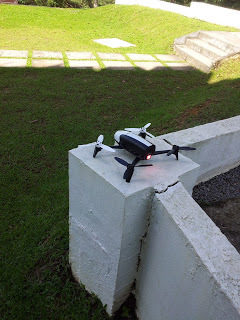
Laure then invited my family along for dinner at Siniawan, an old Chinese town that hadn’t changed much since the mid-1800’s. They had made arrangements to meet with a fifth generation Hakka, a part of the “second batch” (1880’s), after the “first batch” got wiped out during the gold miners’ revolt. He talked about the passed-down history of the town.
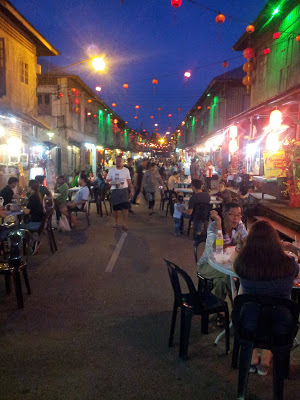
Before we ate a delicious meal that consisted of wild boar, jungle ferns and rojak, Laure asked that we sign release forms for our parts in the filming, including the boys who were amused at “signing” their signatures since they didn’t know how to write—only print.
Already though, I was thinking about tomorrow’s adventure, whereby we would go to Semenggoh for the orangutans and jungle shots, and then upper Sarawak River by longboat to film Peter for the Personal Invitation story and some additional jungle shots to finish off the Maugham story.
—BorneoExpatWriter
*Continue to Part IV, Part V. (*available soon). Link Part I and Part II
 Book orders for Trois autresMalaisie. E-book orders.
Book orders for Trois autresMalaisie. E-book orders.
Here's a link to the intro and excerpts, and to four reviews of Trois Autres Malaisie ineurasie.net, Malaisie.org, easyvoyage.com, and Petit Futé mag .The ARTE TV report will be broadcasted on June 5th: http://www.arte.tv/fr/videos/071100-062-A/invitation-au-voyage. It will be available online until August 4th!
Published on May 31, 2017 08:42
May 30, 2017
Arte: Somerset Maugham and Me—Fort Margherita—Part II
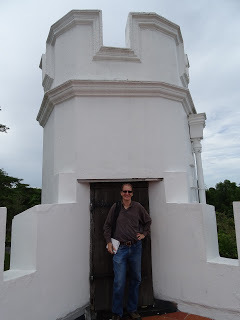
When I visited Fort Margherita in Kuching, Sarawak on the island of Borneo four days before the Somerset Maugham shoot for the Franco-German Cultural Channel Arte to mentally prepare myself (and take notes for a future feature on the BrookeGallery@Fort Margherita), Liza Sedini had warned me that the heads inside the basket in one of the two parapets were now wrapped inside a pua kumbu, a traditional cloth.
Having seen the heads years ago on two previous visits, I admitted I was disappointed. Although assured that three or four human heads were still there, the effect of not seeing the actual heads was clearly not the same….You just have to take Liza’s word for it.
My word, too.
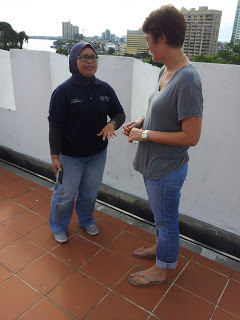 Lisa Sedini and Karen ShephardEither way I was immensely impressed with what they did to Fort Margherita, inside the Brooke Gallery, the fort itself and the surrounding grounds. When I first came to Kuching 18 years ago, the fort was clearly visible across the river from the waterfront, but now, because of the overgrown trees and shrubbery you can barely see it, which is a shame—this is a major landmark and should be a prominent tourist attraction.
Lisa Sedini and Karen ShephardEither way I was immensely impressed with what they did to Fort Margherita, inside the Brooke Gallery, the fort itself and the surrounding grounds. When I first came to Kuching 18 years ago, the fort was clearly visible across the river from the waterfront, but now, because of the overgrown trees and shrubbery you can barely see it, which is a shame—this is a major landmark and should be a prominent tourist attraction.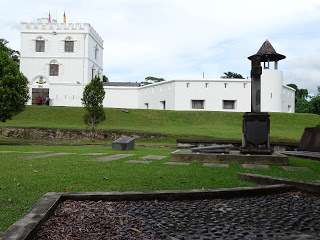
So I am happy that the Brooke Gallery is giving visitors a chance to enjoy Sarawak history inside the splendid fort, and that this film will be presented to a wider European audience as a re-discovery! After those two visits years ago, I was back for the second time in four days for the Maugham shooting.
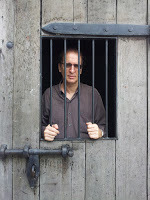
What I didn’t recall noticing on those previous visits were the two jail cells to the left of the exit that led into the courtyard, but Liza pointed them out to me. She even offered to take a photo of me inside….The thought of hamming it up with a big smile never crossed my mind. I put on a long face as I held the bars as if I were truly locked up. I posted the photo on Facebook and told everyone that I had been let out on good behavior…but then I got an idea!
I thought it would be great to be filmed inside the jail for the Maugham shoot and talk about how many of Maugham’s characters had ended up in jail or should’ve ended up in jail for murder or wrongful death. Also, Maugham on numerous occasions had been threatened to be sued for slander since he often wrote about real people, even using real names, like Sadie Thompson who was not pleased that Maugham had not only used her actual name but also made it the original title of his story “Rain”!
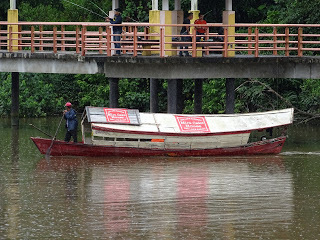
On Sunday morning I arrived at the waterfront at 7:30 and was already on the tambang crossing the Sarawak River, when I got a text message from Karen asking me if I was meeting the others at Grand Margherita Hotel or Fort Margherita? Not having been informed that we were to meet there, I told her I’ll just meet them at the fort. I was nearly at the top of the hill when Karen suggested that I meet them at the jetty below, so back down the hill I went.
Then I saw a group of mostly westerners on the other side of the river, heading toward a tambang. Usually the river ferry could squeeze in 15-20 people, but only half that number if you’re western and carrying a bunch of travel bags and filming equipment. Finally I got to meet Laure, who couldn’t thank me enough for the success they had filming in Kuala Lumpur and Malacca. She said both Bernice Chauly and Serge Jardin were fantastic!
I just hoped I wouldn’t be any less fantastic.
I liked Laure right away; she was easy going with this wide-eyed excitement. She had the natural instincts of a child, where everything is exciting and an adventure. It was refreshing, contagious, too, unlike the usual jaded people you tend to meet and work with. This was the way to live—by enjoying the moment and seeking out adventures! When looking back over our lives it’s the adventures and those misadventures (that weren’t all that funny at the time) that we truly treasure.
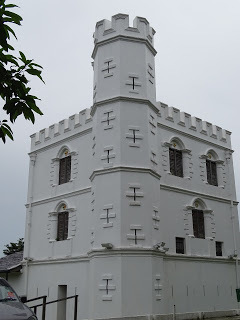 While waiting for Jason Brooke, the sixth generation of the Rajah Brookes, to arrive, Richard shot some footage outside Fort Margherita along with Michel Viet, hired for his drone, giving them a bird’s eye view.
While waiting for Jason Brooke, the sixth generation of the Rajah Brookes, to arrive, Richard shot some footage outside Fort Margherita along with Michel Viet, hired for his drone, giving them a bird’s eye view.  Michel VietKaren, Laure and I were standing at one of the two parapets, enjoying the commanding view when Richard waved us away since Michel’s drone was heading toward us.
Michel VietKaren, Laure and I were standing at one of the two parapets, enjoying the commanding view when Richard waved us away since Michel’s drone was heading toward us.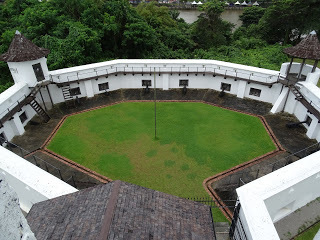
We ducked inside the Brooke Gallery.
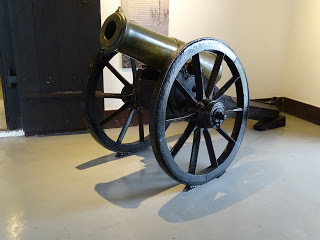
I pointed out to Laure the cannon that had been brought to Sarawak in Rajah Brooke’s determination to defeat Rentap, a notorious Dayak warrior, a headhunter, a pirate…or an Iban freedom fighter—a matter of perspective. It was said that 500 Dayaks had to drag the cannon up a hill to do battle at his longhouse. I had no idea how many men had battled to get the cannon inside Fort Margherita.
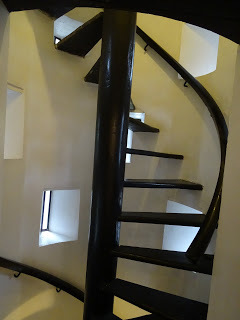
The Brooke Gallery had nine sections and a spiral staircase between each floor and the rooftop, each with thirteen belian steps (so 39 steps altogether). The nine sections are: The Allure of Borneo, Raiders and Rebellion, Birth of the State, Building Sarawak, Life in Brooke Sarawak, The White Raja, Sarawak on the World Stage, Rebirth of Sarawak, and The Brooke Legacy.
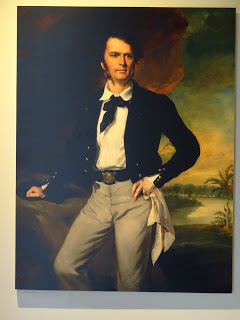 Rajah James BrookeWhile they interviewed Jason Brooke on the pepper trade, Laure came around during a break to put me at ease and to let me know the questions she was going to ask. She informed me that while I would be speaking in English, my words would also be translated into French and German, and there would be cutaways to other scenes filmed in Kuala Lumpur and Malacca.
Rajah James BrookeWhile they interviewed Jason Brooke on the pepper trade, Laure came around during a break to put me at ease and to let me know the questions she was going to ask. She informed me that while I would be speaking in English, my words would also be translated into French and German, and there would be cutaways to other scenes filmed in Kuala Lumpur and Malacca.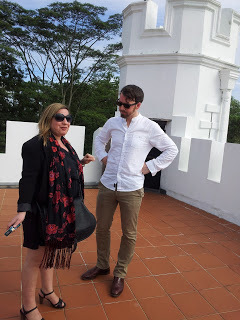 Laure Michel and Jason Brooke
Laure Michel and Jason BrookeI ran by her my take on the jail shoot and what I planned to discuss if they agreed. Her initial concern was that there might not be enough light, let alone room for Richard to maneuver the tripod.
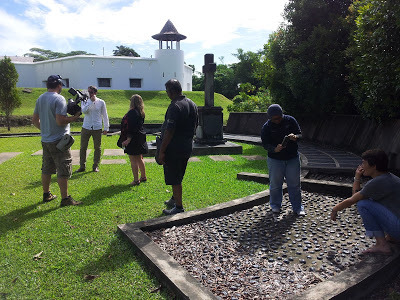 When it came time for my interview I showed a skeptical Richard what I had in mind, and then I got this brilliant idea. I suggested that we open the heavy wooden jail door perpendicular to the actual jail, that way he could shoot from in front, with plenty of light and plenty of room, and if we closed the matching wooden doors behind me that led into the gallery, we would give the impression we were filming in jail, with me behind bars.
When it came time for my interview I showed a skeptical Richard what I had in mind, and then I got this brilliant idea. I suggested that we open the heavy wooden jail door perpendicular to the actual jail, that way he could shoot from in front, with plenty of light and plenty of room, and if we closed the matching wooden doors behind me that led into the gallery, we would give the impression we were filming in jail, with me behind bars.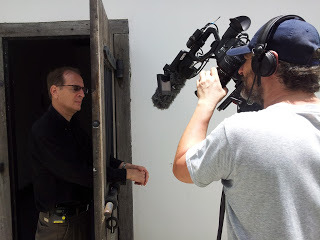
Richard went for it. He informed Liza to knock to let him know when tourists were coming out. The tourists would do a double take and give me this strange look as if to ask, “What are you in for?”
Once Richard gave me the go ahead, I went into my Maugham spiel about how many characters in the Borneo stories should’ve ended up in jail like Neil MacAdam the title character who left his boss’ Russian temptress wife alone deep in the jungle, thus sealing her fate. Or Warburton in “The Outstation” who knew exactly what was going to happen to Cooper (end up with a kris stuck in his back) and let it happen. Or Norman in “Flotsam & Jetsam” who killed his wife’s lover, Jack.
Maugham wrote, “She had to stay—or starve, and Norman had to keep her—or hang.”
Maugham wrote in “Before the Party”: “If you try and hush a thing up, all sorts of rumors get about which are ten times worse than the truth.”
In Maugham’s stories, which were often sensational, the truth was usually far worse. When Millicent confessed to her family what really happened to her “non-drinking” husband back in Borneo, that it was not a heart attack that she had claimed eight months ago, nor did he “commit suicide” as they had recently discovered from another, but she had slit her husband’s throat because of his drinking.
Maugham was already a celebrated novelist and playwright when he visited Sarawak, so people opened their doors to him, glad for the company; but when they found out what he had written about them, exposing their affairs and a few other skeletons, they were not too pleased.
Although he renamed Sarawak “Sembulu” and Kuching “Kuala Solor,” the thin disguise was easy to see through. Even if he changed the characters names, since there were so few Europeans in Sarawak on those lonely outposts between the wars, it was easy to figure out whom he was writing about.
When he returned five years later, those same doors were no longer open to him. Some were outraged by what he had written and even threatened lawsuits; others were jealous they were not written about!
But those Borneo stories brought scores of tourists to Sarawak!
When I finished what I had to say (saving the rest for the other locations), Richard filmed me from various angles, then had me come through those double doors and walk to the interior of the fort where there were thirteen cannons waiting to be fired at the enemy that never came.
Up until the mid-60’s, they used to have a cannon in front of the fort that would be fired every morning at 5:30 and in the evening at 8:00. No doubt, a headache for many people within earshot.
Later, I was filmed walking in various locations outside the fort including traipsing through some banana trees….Of course, this wasn’t a jungle (that would come later), but it would look good on film. Next up, the French were invading my house!
—BorneoExpatWriter
*Continued Part III, Part IV, Part V (*available soon). Link Part I
 Book orders for Trois autresMalaisie. E-book orders.
Book orders for Trois autresMalaisie. E-book orders.
Here's a link to the intro and excerpts, and to four reviews of Trois Autres Malaisie ineurasie.net, Malaisie.org, easyvoyage.com, and Petit Futé mag .The ARTE TV report will be broadcasted on June 5th: http://www.arte.tv/fr/videos/071100-062-A/invitation-au-voyage. It will be available online until August 4th!
Published on May 30, 2017 20:46
May 29, 2017
Arte: Somerset Maugham and Me—Filmed for the Franco-German Cultural Channel: Part I
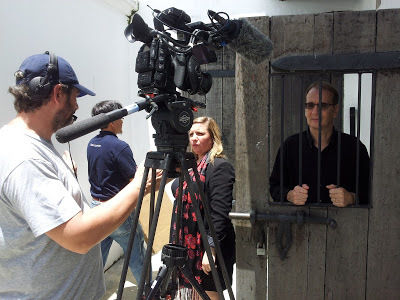 Richard Cloue, Laure Michel and Robert Raymer at Fort Margherita
Richard Cloue, Laure Michel and Robert Raymer at Fort MargheritaThree weeks after receiving an out-of-the-blue email from France, I found myself being filmed in Borneo talking about Somerset Maugham for the Franco-German Cultural Channel Arte for a program called “The Invitation to Travel” or L’Invitation au Voyage. I was filmed in three locations (not counting outtakes in the jungle) over two days: Fort Margherita, my office, and on the riverbank at Kampung Git.
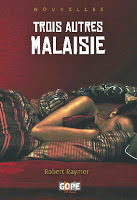
Having read Trois autres Malaisie, the French translation of Lovers andStrangers Revisited, Laure Michel, French journalist and cultural documentary filmmaker contacted me with the help of Shan Iman, a Production cum Location Manager & Fixer, hired to liaise and organize their two week trip to Kuala Lumpur, Malacca and Sarawak. Their initial goal was to film a segment on “Sensual Malaysia of Somerset Maugham” (“Sensuelle Malaisie de Somerset Maugham”) and also “The Pepper of Sarawak” since it’s venerated by the great chefs of Paris.
I knew nothing about the pepper industry, even though my neighbor recently started to grow it next door, but I am vaguely familiar with Maugham, having read a collection of 65 of his short stories more than once, his autobiography The Summing Up, and numerous accounts of his life and his visits to Malaya and Borneo over the past several decades…
I first became intrigued with Maugham back in 1980 when I visited the old Raffles Hotel in Singapore, before it was heavily refurbished, aware that Somerset Maugham had stayed there.
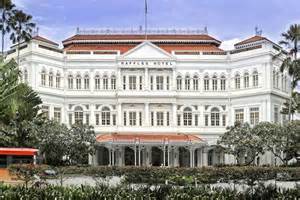 Then in Penang, at the old E & O Hotel, inside the 1885 Room, I once wrote, “I glanced around at the other hotel guests and patrons…the Westerners, in particular. They all seemed to have a somber, yet dignified look about them like characters stepping out of a story by Joseph Conrad or Somerset Maugham, both of whom had reputedly stayed there.”
Then in Penang, at the old E & O Hotel, inside the 1885 Room, I once wrote, “I glanced around at the other hotel guests and patrons…the Westerners, in particular. They all seemed to have a somber, yet dignified look about them like characters stepping out of a story by Joseph Conrad or Somerset Maugham, both of whom had reputedly stayed there.” Admittedly, like most expat writers of fiction who have lived in or visited Malaysia, I like to think that I’m following in the footsteps of Maugham. Few writers, however, have ever achieved his success as a novelist, as a playwright, as a short story writer—let alone all three disciplines.
After deciding to take up the challenge, I needed to brush up on my Maugham, so I reread The Summing Up, his Borneo stories, others set in Malaya including “The Letter” and a few celebrated stories like “Rain” set elsewhere.
Unlike Anthony Burgess who taught in Malaysia and Rudyard Kipling and EM Forster who lived in India, Maugham was just passing through, so he had no vested interest; therefore he could be objective and critical of the British Raj, even poke fun at them.
I knew I could never be a “Maugham expert” in a few weeks, so I decided to focus my attention on his two visits to Sarawak in the 1920’s. That’s when I discovered a gem…that back in 1921, Somerset Maugham nearly died in Sarawak.
While paying a visit to the third White Rajah Brooke of Sarawak, Maugham traveled by boat with his friend and companion Gerald Haxton downstream near present day Sri Aman, when the sudden rush of the ten-foot wave from a tidal bore swamped their small craft and sent Maugham, Haxton, and the native crew into the river where they barely survived.
Had Somerset Maugham drowned in that tidal bore, he would never have written the short story “The Yellow Streak” based on that very near-death encounter. Nor would he have written any book after The Trembling of a Leaf: Little Stories of the South Sea Islands. There would be noThe Painted Veil, no The Casuarina Tree, no Cakes and Ale, no The Razor’s Edge, and no Ashendon—and possibly no James Bond since Maugham’s spy stories had inspired Ian Fleming!
Instead of living to be 91, Somerset Maugham would have died at age 47!
Suddenly I became excited by the possibilities.
Then I thought if I could write an article on Somerset Maugham in Sarawak, beginning with that near drowning episode since it was so dramatic, it would help to crystallize my thoughts and prepare me for my talk.
I Googled and read nearly two hundred pages on Maugham from dozens of interviews, book reviews of several biographies, and a few critical analyses of his Borneo stories and his writing style. I also consulted several books on hand, including a full chapter on Maugham’s writing in the South Seas, and my set of Britannica encyclopedias (from high school)—researching not only Maugham, but also Malaya, Sarawak, Borneo and other related topics, plus I spent a full afternoon at a library…. Afterwards I had ten single-spaced typed pages of usable notes.
This was taking far more time than I had, so I decided to abort writing the actual article until later, and just focus on the task at hand—being able to talk competently about Maugham, not as an academic presenting a paper at a conference, but as a fellow writer (which was why they chose me instead of a historian) giving a lively account of his time here and the stories he wrote.
Having written extensively about Malaysia and having lived in Sarawak for ten years, I now had to make this personal connection to Maugham and have that come across on film.
So I broke down those ten pages into five distinct parts: Maugham Country; Maugham the traveler; Maugham’s ideas for his stories; Maugham being criticized; and Maugham’s jail-bound characters (and those that should’ve been)….I distilled these into five handwritten pages in a medium-size notebook.
Then I underlined the key phrases and quotes and tossed the rest until I got the essential down to two index cards (front and back) that I could practice off camera and elaborate more freely while being interviewed. I knew that, unlike a presentation, these five parts were not going to be in order—even within the same part—since I would be fielding questions from an interviewer.
Plus I had to plan out which part would be most relevant to where I was being filmed—still up in the air. So I had to be extremely flexible….That was my plan.
Once it was confirmed (the day before the shooting) that we would start at Fort Margherita (and not in the jungle), I knew I needed to start with the last section first and I knew exactly where I wanted to be while being filmed—in jail. I just had to sell that idea to Laure and her chief filming operator, Richard Cloue, to make sure it happens.
In the midst of all this, I was in communication with several other writers so Laure could interview them in Kuching, in Kuala Lumpur, and in Malacca. For some, the timing (and the short notice) was all wrong, so they couldn’t commit. Jerome Bouchaud, who translated my book Trois autres Malaisie and is the author of Langkawi Style, strongly recommended a fellow Frenchman, SergeJardin, author of Malacca Style, for Malacca.
When Laure filmed him before coming to Kuching, she was impressed that he not only read my book but had it on his shelf next to Somerset Maugham.
I also put Laure in contact with Bernice Chauly, author of Growing Up with Ghosts, for the Kuala Lumpur segment. Like me, Bernice was reluctant to reply to that initial out-of-the-blue email, so I told Laure I’d track her down via Facebook, and then I sent a copy of Laure’s email and attachment, spelling out their filming plans. She came on board and Laure couldn’t praise her enough.
I was relieved that both of those interviews worked out well. They also managed to film inside the Royal Selangor Club, or “The Spotted Dog”, for their segment on cricket as part of the Maugham story and even got to meet a Prince!
For the Sarawak pepper story, I put Laure in contact with Karen Shepherd who writes for Kino (Kuching In and Out). Another writer had suggested that her husband Peter John Jaban could be a big help, and he was!
Thus began a slew of emails between Laure and me, Karen and me, and then Laure and Karen together as I tossed about ideas, including lobbying for shooting at Fort Margherita. Initially Laure was skeptical; she wanted to avoid Kuching town and wanted to interview me at my house and in the jungle…
I then suggested Semenggoh Wildlife Centre, a former orangutan sanctuary, now more like a half-way house, only fifteen minutes from where I live.
Soon Karen took on a heavier role as part of the production team and would get paid, too, which I was glad to hear, unlike the rest of us being interviewed—we had to sign off those rights.
Karen proved invaluable and Laure was so glad I had brought them together. Not only would Karen be interviewed on the pepper trade, but through Peter, who was Iban, they had arranged to visit some pepper plantations and even rent a longboat for a trip on the upper Sarawak River that I would get to tag along with for my jungle shot.
My initial reaction, “An adventure!”
Also, Laure planned to do a third film on Peter, for a segment called “A Personal Invitation,” a discovery of a wild place close to Peter’s heart.
Coincidentally, when Laure arrived in Kuala Lumpur, Karen and Peter were in town for a wedding, so they met to finalize arrangements for the various Sarawak shoots—now three projects at multiple locations spread over five days.
When they couldn’t obtain a filming permit at Semenggoh, since they required a full month notice, I suggested we go there anyways for the morning feeding time; that way they could at least film the orangutans as a tourist and work that footage into their documentary.
I also contacted Liza Sedini, the manager of the Brooke Gallery@FortMargherita. I had done a tiny piece on the gallery for Silk Air for their March ‘17 issue. Years before, I had visited Fort Margherita twice, so when this Maugham project came up, I asked Liza if she had anything on Maugham’s meeting the Third White Rajah. She suggested that I contact Jason Brooke, the sixth generation of the Rajah Brookes, in London, so I sent him an email.
Then I found out from Liza, while making plans to visit the gallery to brush up on my White Rajah history, Jason Brooke was flying into Kuching that same weekend for another event. I immediately lobbied both Laure and Karen that they should arrange an interview with Jason Brooke at Fort Margherita—imagine meeting a descendant of the White Rajahs at the Fort!
Karen thought this was a great idea; like me, she was skeptical of the jungle shoot since neither of us could visualize Somerset Maugham in the jungle. Besides, they would have plenty of jungle on the pepper story, and they would need some town shots of the various pepper middlemen and traders.
Between the two of us, on the day before the shooting, we finally got Laure to agree on Fort Margherita and also Jason Brooke to agree on being interviewed on the pepper trade. Liza and I had been keeping him on standby since we knew this would be great publicity for the Brooke Gallery, which had just opened in September 2016.
Since Jason’s flight back to London was Sunday afternoon, it was agreed that we would meet at Fort Margherita after Liza had volunteered to open the fort two hours early, at 8am for us.
—BorneoExpatWriter
*Continued Part II, Part III, Part IV, Part V (*all available later this week)
 Book orders for Trois autresMalaisie. E-book orders.
Book orders for Trois autresMalaisie. E-book orders.
Here's a link to the intro and excerpts, and to four reviews of Trois Autres Malaisie ineurasie.net, Malaisie.org, easyvoyage.com, and Petit Futé mag .
The ARTE TV report will be broadcasted on June 5th: http://www.arte.tv/fr/videos/071100-062-A/invitation-au-voyage. It will be available online until August 4th!
Published on May 29, 2017 21:49
May 28, 2017
Spirit of Malaysia from Kuala Lumpur to Colorado
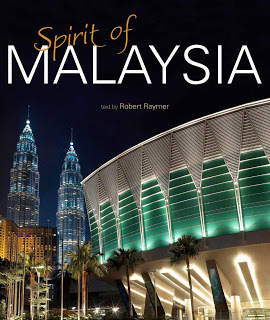
My brother, who lives in Colorado, recently wrote that he and his wife were at a friend's house for a party. His friends had just come back from visiting several different countries in Southeast Asia, including Malaysia (Kuala Lumpur).
My brother said he happened to notice a copy of my book Spirit of Malaysia lying around (I wrote the text), something that his friends had picked up during their travels. He held it up for everyone, pointed out my name on the cover and told them, "That's my brother."
They all thought that was pretty cool, quite a coincidence too.
For me, it felt good being the life of the party, at least for a few minutes, and also knowing that my book gets around—from Kuala Lumpur to Denver, Colorado…
Published on May 28, 2017 04:28
November 29, 2016
Winners of the 2016 William Faulkner - William Wisdom Creative Writing Competition.
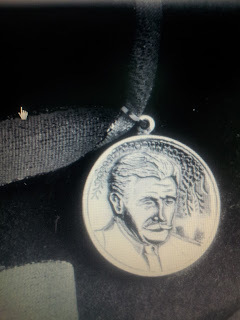
Congrats to the winners of the 2016 William Faulkner - William Wisdom Creative Writing Competition.
THE WINNERS:
Novel: Millard Salter Will Kill Himself This Evening, Jacob Appel, New York, NY
Runners-up: The Last Bird, (The Life of Adrian Mandrick), Chris White, Bainbridge, IN
Narrative Non-Fiction: How to Eat Ali’s Mother, Adriana Páramo, Kissimmee, FL
Runners-up: Land’s End: Field Notes and Photos from “the End of the World,”
C. E. Richard, Lafayette, LA
Losing Glynnis, Roz Kuehn, New York, NY
Novella: Terminal, Andrew Plattner, Atlanta, GA
Runners-up: Drunk with Fire, Daniel Turtel, New York, NY
The Sealed Room, J. L. Montavon, San Francisco, CA
Novel in Progress: Took, Brenda McClain, Ashland City, TN
Runners-up: Letters from the Front, Barnes Carr, Houston, TX
River, Steal, Rachel Lyon, Brooklyn, NY
Congrats to Jacob Appel who last year was runner-up in both the Novel and Novel-in-Progress.
As for Taking the Expat Exit, it remains as a finalist in the novel category.
—Borneo Expat Writer
Published on November 29, 2016 05:49
September 7, 2016
POPCLUB, September 2016

Got a nice mention and a good photo of me speaking to the participants at the Popular Children's Book Writing Workshop in the September 2016 issue of POPCLUB from Popular Books.
Dr. Gan Siew Hua, author of Given Another Chance, one of my editing clients and recently featured in The Star, also got a nice mention, as did the other speakers Eliza Teoh, Heidi Shamsuddin, Jonathan Ng, and Yusof Gajah.
I first met Dr. Gan at last year’s Popular Bookfest Writing Workshop in Kuala Lumpur, and she approached me about hiring me to edit her story that she wrote during one of my sessions. That story led to another and another and she kept churning out first-person stories about her insightful experiences which landed her a book deal. Then I met her recently in Kuching and again in KL at this year’s workshop, where she was back with her daughter, hoping to pick up more pointers, and write another book. While in KL, Dr. Gan passed me an autographed copy of her book that contained a generous acknowledgement:
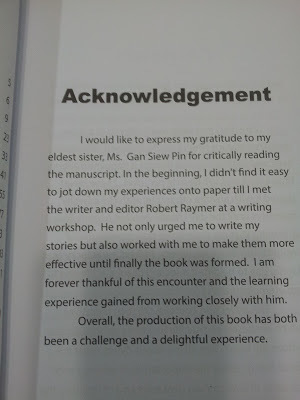
Published on September 07, 2016 19:44
August 21, 2016
Taking the Expat Exit – Finalist 2016 Faulkner-Wisdom Novel Awards
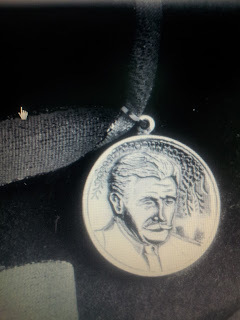
Taking the Expat Exit (formerly A Perfect Day for an Expat Exit) was named finalist for the 2016 Faulkner-Wisdom Novel Award. (In 2014 it was short-list finalist and a finalist 2012.) Last year, the sequel Caught in a Mousetrap: Expats at Play (formerly The Girl in the Bathtub), was also a finalist (and a finalist for 2012 Novel-in-Progress category). Both are set in Penang, Malaysia.
This year, for some reason, Caught in a Mousetrap: Expats at Play was only a semi-finalist along with two other novels, The Summer of Sizzle (my latest, completed in May) and An Unexpected Gift from a Growling Fool, a short-list finalist in 2013. Another novel, The Resurrection of Jonathan Brady, was a short-list finalist in the 2014 Faulkner-Wisdom Novel contest (and Quarter-finalist in 2012 Amazon Breakthrough) and my novella The Act of Theft, a finalist in 2014 Novella category.
Judging can be rather subjective, though my two Malaysian-set novels seem to strike a chord with the judges. At least one of my novels has been a finalist or a short list finalist in the Faulkner-Wisdom Novel Award every year since 2011. Not a bad track record. Shows I’m consistent as I persistently rewrite them as I write new novels. Hopefully this year, one can finally win.
While waiting for the 2016 results, it’s back to work on my sixth novel, having compiled notes on it for nearly two years. Sooner or later, one of my novels will break out. It’s only a matter of time. Having recently slogged my way through a third marathon, I know what it’s like to keep at it, advice I gleaned from Dory.
—Borneo Expat Writer
Published on August 21, 2016 18:48
August 16, 2016
2016 Kuching Marathon – My Less Than Charming Third Marathon
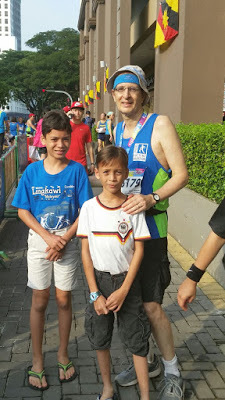
“Why the unusual distance, 42 km?” asked my wife, as I mentally prepared myself to run my third Kuching Marathon.
“Actually it’s 42.195 km, or 26 miles, 385 yards,” I replied. “That was the distance between Marathon and Athens that the legendary messenger Pheidippides ran after the Greek victory over the Persians at the Battle of Marathon in the year 490BC.”
Pheidippides, after delivering his message, promptly died of a heart attack. So here we are 2,500 years later still celebrating his feat with our own feet. Back then, Pheidippides didn’t have the comfortable running shoes nor was the terrain all that smooth let alone paved, nor were there water stations with isotonic drinks conveniently located along the way. So what he did back then was truly remarkable and truly appreciated by those of us who try to emulate him by running our own marathon.
Then again, Pheidippides didn’t start his marathon at 2 a.m. unlike here in Borneo.
Up at 12:45 on less than three hours of sleep, I showered, dressed, stretched, and applied muscular ointments and some Vaseline to prevent chafing. I then took a pre-race selfie before I continued to cross off items from my to-do list, including slipping on my headband and running hat. I was nearly out the hotel door, when my wife surprised me with a kiss and wished me good luck.
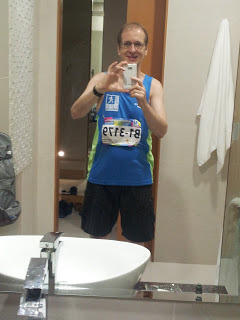 Smiling, I felt ready to do Pheidippides proud by participating in the 2016 Kuching Marathon, an event I ran last year and also in their inaugural event (and my first marathon) in 2014.
Smiling, I felt ready to do Pheidippides proud by participating in the 2016 Kuching Marathon, an event I ran last year and also in their inaugural event (and my first marathon) in 2014. In the elevator, I greeted another runner, a young woman, who told me, “Everyone thinks I’m crazy.”
“I know, including my wife.”
We wished each other good luck. Staying at The Waterfront Hotel, we reached the starting line in about a minute and I never saw her again, which was not unusual when you have about 2000 runners and their non-running friends, milling around, stretching, chatting, while mentally preparing themselves to run an insane distance and endure some minor and major aching along the way.
“No pain, no gain,” they say, which prompted me to ask one of the volunteers as he rode alongside us on his bike, “Aren’t you cheating?”
He didn’t seem to appreciate my humor. Moments later, trying to free himself from the crowd, he veered toward me, so I stopped to let him pass (as opposed to letting him ride over me), but then he swerved at the last second, and we nearly collided. Luckily, neither of us fell.
Not a good way to start a marathon. I got stopped again at the hour mark by a red light and the traffic police. Being forced to stop when you’re running at a good pace is not good. Fatigue sets in as you cool your heels. My plan was to run the first two hours without stopping for anything, even water, since I carried my own bottle. Twice in the past two weeks, I had run to my wife’s village in Sarawak, taking a longer route than usual, and made it there and back in 1 hour, 50 minutes, so I knew it was manageable.
When I did those runs, I did keep a close eye out for that king cobra that my wife had encountered earlier on that same road.
“What is that?” she asked herself, seeing what looked like a rope in the middle of road that seemed to be moving. Suddenly it turned and reared up and fanned out its hood as king cobras tend to do. Eighteen feet in length, king cobras can rise five to six feet and look you in the eye. Luckily for her she was safely inside her car. Realizing it was no match for her Toyota Vios, the king cobra maneuvered out of the way, as did my wife, swerving around it. This meant that the king cobra was still alive, out there somewhere in my path, waiting…
I made contingency plans of what I would do if I happened to encounter that king cobra. Since I always run with a long white plastic pole to fend off dogs – I get chased at least once on every run, and sometimes I’d have as many as four or five dogs surrounding me, going for it. I’d swing my stick and carefully back away from them. Other than scaring me half to death, so far not bites.
A bite from a king cobra would be lethal, so I planned in my head what I would do if I was forced to fight it off wielding my stick. In my mind, I always win; in reality, that may not be the case. So I kept running, hoping if I did see that king cobra or any other snake, I could at least outrun it. A woman running a marathon in New Mexico was attacked by a bear. Yes, other than cars, there are risks.
As I continued my own marathon, though without my pole, I did smell death on several occasions – no doubt some roadkill just out of my line of vision. Out of sight, out of mind, so I kept on running.
The first two Kuching Marathons ran without a hitch, but this year there were some problems. The 14-km water station ran out of cups, which made it difficult for people to drink and slow for the rest of us waiting for a bottle. When my turn came, I refilled my own one-liter bottle. Then at the 17-km water station (they were spaced three kilometers apart) they had neither cups nor water nor isotonic drinks. I still I had plenty in my bottle, but others grumbled. I heard a few caustic remarks tossed at the hapless volunteers, who informed us that they had informed the organizers, not that it would do us any good.
At the next station, near the half way point, they had cups and drinks, but the following 23-km station, they were out again and that made quite a few people upset, if not angry at the organizers. Running a marathon is hard enough on your own without having to worry about not having any water at the water stations. In the past, I often wondered if the extra weight and hassle of holding my own bottle for 42 km was worth it. Now I had my answer. I felt bad for all those waterless runners, knowing how thirsty they must be.
Around the half way mark, my knees began to ache as did my lower legs. I had to walk out of sheer fatigue, but my knees seemed to ache even more, so I compelled myself to run, albeit slowly, but I was too tired to run and needed to walk, but my knees were too achy to walk….This was not a good sign.
Then everybody seemed to be passing me, male and female, young and old, tall and short, chubby and skinny, even two guys with one arm. One man’s arm was lifeless, dangling from his left side, the other surgically removed below the elbow. I immediately thought of the victims from the 2013 Boston Marathon bombing and how courageous so many of them were, after losing a limb, including a leg, to return the following year and run again.
Although inspired, I still continued to fade. Then this man in his fifties, wearing a tutu, passed me.
“Stop it,” I said. “Enough is enough.”
I turned to a tall Indian a few steps behind me, pointed out the other man and said in disbelief, “He’s wearing a tutu!”
The man nodded. It’s hard to ignore a grown man in a tutu.
“What’s really embarrassing,” I added, “is that he’s beating both of us.”
Later, feeling even more demoralized as people who didn’t really look like runners – including old ladies, chubby guys and even school girls – kept passing me, I began to lose hope. How embarrassing, I thought. Is this the best I can do? I started to have serious doubts. Can I even finish this race? Then a busload of pooped-out marathoners slowed down as it passed by. I admit the temptation was there, but I waved them on. One way or another I was determined to finish this race under my own volition, and also within the cut off time of 6 hr 30 min to qualify for a medal.
I know I needed a miracle.
A long-haired angel appeared beside me and asked, “Where are you from?”
“America,” I replied. She was the first person to speak to me the entire race, not that I was in a-speaking-to mood, being in constant pain.
“You came all this way, or do you work here?”
I admitted that I live here and that I write novels, though not everyone would call that work unless you sell them and they get turned into movies and you become rich and famous. One of my Malaysian short stories did get filmed by Ohio University, does that count?
Suddenly this angel, who hails from West Malaysia, broke into a song playing on her MP3, “Stand By Me.”
I was hoping she would stand by me a lot longer, at least until the song finished – she had such an angelic voice. But, alas, she said, “See you at the finish line,” and just like that she vanished.
I missed her. I missed everyone who passed me, but this angel gave me what I needed – hope. Hope that if I persisted, if I didn’t give up as others had done, that I could be just like her and finish the race and even receive a medal for my efforts.

With that in mind, pain or no pain, I stepped up my pace.
I knew I was cutting it close to the cut off time, so I kept doing whatever I could do to compel my body to move forward. It wasn’t always pretty, but the end of marathons for most runners (unlike the first six Kenyan winners and those who train properly) rarely is.
Then I saw another sign. Not from heaven, but in front of me. It stated five kilometers to go. The next sign stated four kilometers to go. Then three kilometers. Then two. Finally, just ahead of me was the one kilometer to go sign.
Another runner said to me, “I never realized how far one kilometer could be.”
I nodded in agreement. “Even the sign,” which we had yet to reach, “seems awfully far away.”
Then we heard shouts from the volunteers that were promptly relayed by the other runners walking home, “Five minutes to go before the cutoff!”
“I can do this,” I kept telling myself.
Soon it became, “Two minutes before the cutoff!”
Not about to run all this way and not get that medal, I pushed past the pain and even thought of my wife waiting for me at the finish line with another kiss.
“One minute to go,” I heard, so I really poured it on. I sprinted in slow motion. Or tried, too. I even pretended that this was the Rio Olympics where all the best marathoners in the world were preparing for their big race. I ran for the finish line and graciously accepted a medal and triumphantly flung it around my neck. It wasn’t gold, but nevertheless, I got it! With some divine help....Lucky for me, and those behind me, since I missed the actual cut off time by a mere forty-five seconds, they gave us a little grace time.
Now and then, all of us deserve a little grace time, and I do appreciate the organizers for that!
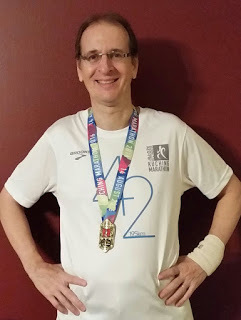
When asked why he wanted to climb Mt Everest, which no man had even done back then, George Mallory famously replied, “Because it’s there.”
The same could be asked of all of us who run marathons. Two years ago, when I took up the challenge to run my first marathon, I would have replied, “Because I want to be fit.”
For my second marathon, I would have replied, “Because I want to prove that I can still do it and beat my previous time! But now, although I failed to beat my personal best time, I would reply, “Because I can.”
Although this year, I admit, I had some serious doubts... A question for those of you who have never completed a marathon, “Are you up to the challenge?”
I can assure you that Pheidippides would be honored that you have chosen to celebrate his amazing feat. That’s exactly what I did – for the third time.
—BorneoExpatWriter
# # #
Published on August 16, 2016 19:26
June 19, 2016
Writing a Novel, Running a Marathon, and Advice from Dory
 Having recently entered five novels into the 2016 William Faulkner - William Wisdom Creative Writing Competition in mid-May, I was determined to start a new novel in June and then run a third marathon in August. Last year one of my novels was a finalist for their 2015 contest, one of four novels that have been finalist or short-list finalist for Faulkner-Wisdom Novel Competition.
Having recently entered five novels into the 2016 William Faulkner - William Wisdom Creative Writing Competition in mid-May, I was determined to start a new novel in June and then run a third marathon in August. Last year one of my novels was a finalist for their 2015 contest, one of four novels that have been finalist or short-list finalist for Faulkner-Wisdom Novel Competition. After a marathon performance of rewriting those same four novels for this year’s contest, plus adding a fifth novel that I adapted from a screenplay, I was determined not to let up. I’m not getting any younger. I was equally determined two years ago to run my first marathon (for the same reason). My wife told me I was crazy. So I ran a second marathon last year to prove that I was crazy.
I admit rewriting five novels back to back is extremely crazy, but what to do? I want to win and I want all five novels published and when it comes to fiction there’s always seems to be room for improvement. But after all of that editing and rewriting (1,568 pages since I went through each novel twice, so it’s actually 3,136 pages that I also read out loud), and then to start in on a sixth novel so quickly? That’s just plain insane.
Okay, I did take two weeks off to write to some agents and to rewrite some short stories….But I was itching to start on that new novel. Fortunately, I wasn’t starting cold, which can be daunting. For two years I had been keeping notes and have about 200 notebook pages, plus a pile of loose notes that I’m now typing up and tossing into four sections: Part I, Part II, Part III and Not Sure Where the Hell it Goes. Hopefully, I’ll figure out that last section later…
Writing a novel, by the way, is like running a marathon. First you have to show up at the starting line raring to go...after mentally and physically preparing yourself for the insanity. Once you show up, you got a fifty-fifty chance of completing it so long as you follow Dory’s advice from Finding Nemo and also Finding Dory, “Keep on swimming. Keep on swimming.” Unlike a marathon which you can complete in several hours, you got to show up at the starting line of your novel in front of your computer day after day, week after week, month after month.
That often means gluing your butt to the chair so you won’t get up every five minutes to look for a distraction. Besides you got plenty of distractions in front of you – the Internet, email, social media, not to mention all those other temptations a click or two away, like checking your likes or messages on your phone.
Once you complete that first draft, regardless of how bad or good you think it is, you have to do the same for the second draft, so “Keep on writing. Keep on writing,” though mostly you’re rewriting….Writing a second draft often feels like running a second marathon right after you finished the first, regardless if you’re too tired, not in the mood or still suffering from cramps. I waited a whole year to run my second marathon, so I know what that feels like. By the way, no matter how many marathons you run, you still got to cover 26 miles and 385 yards or 42.195 kilometers or in other words,you got to "Keep on running. Keep on running." Being familiar with the landscape does help. This also applies to writing that second draft.
Still, you got to keep showing up at the starting line as you plow your way through it, mile after mile, chapter after chapter. The third draft feels like a half-marathon since you can reach the finish line a lot quicker assuming you put the hard work into the previous two drafts. Sloppiness and shortcuts will only slow you down in the long run.
Unfortunately you’ll probably need a fourth and a fifth draft (and a whole lot more races to run) to get the novel cleaned up and whipped into shape, so “Keep on rewriting. Keep on rewriting.”
Before you know it, you can see the finish line ahead of you. Now you can start entering it into contests to see how it stacks up to the competition. If you’re not making it to the semi-finals nor the finals, you got a lot more work ahead of you, so hold off before you submit it to agents let alone publishers. Later, after you polish it up and after others have read or edited it, you can always self-publish it yourself if only to test the market and to prove to yourself and friends (and major publishers) that you have a novel that’s worth looking into.
By then, you’ll no doubt have other ideas and plenty of notes for future novels that you’ll be eager to start on. You know the mantra. You suck it up and just like Dory, “Keep on swimming. Keep on swimming” until you arrive.
Published on June 19, 2016 21:18
Robert Raymer's Blog
- Robert Raymer's profile
- 3 followers
Robert Raymer isn't a Goodreads Author
(yet),
but they
do have a blog,
so here are some recent posts imported from
their feed.



